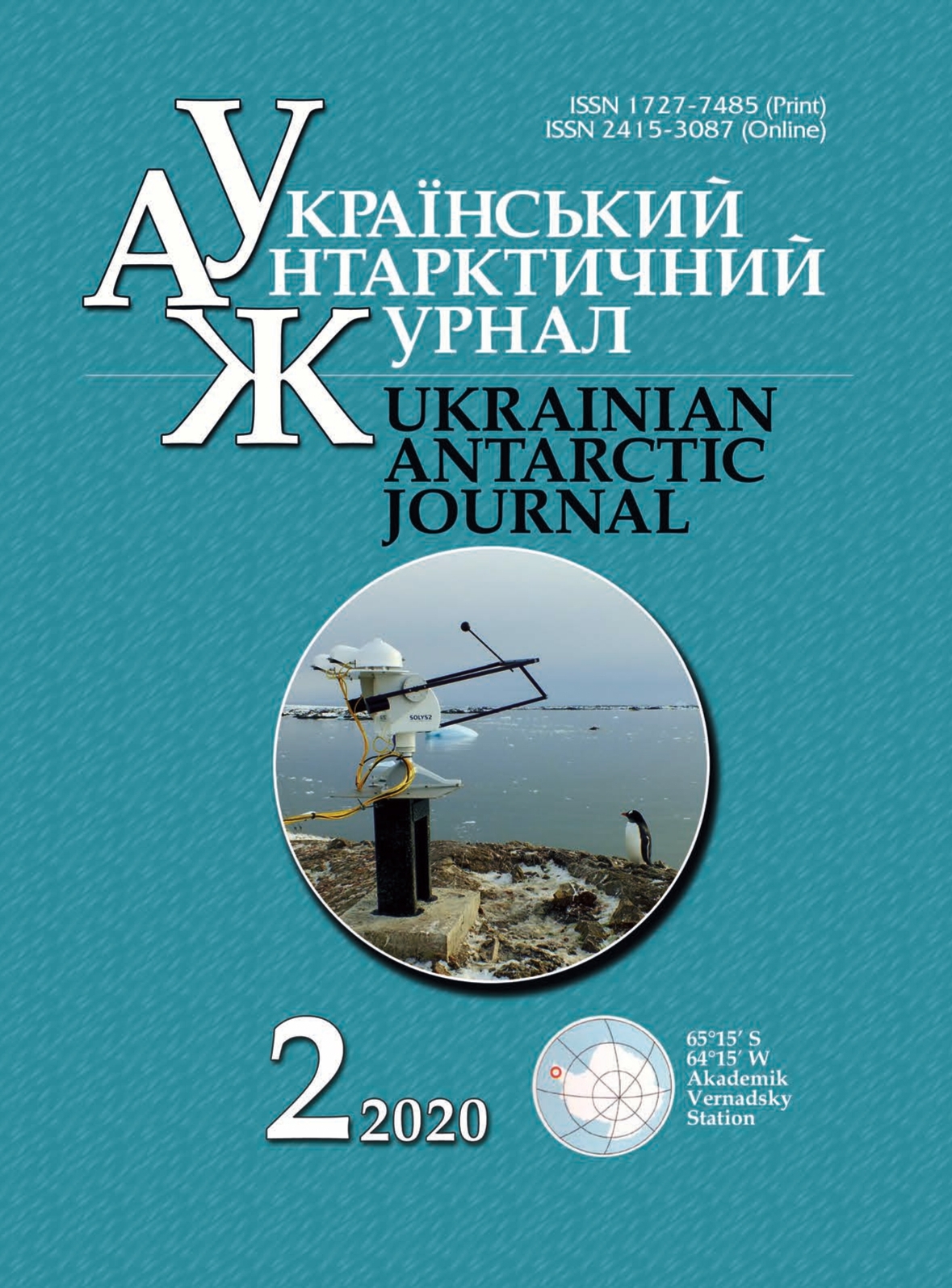Покращення деталізації моделювання атмосферних процесів за допомогою моделі Polar WRF на прикладі випадку сильних опадів у районі антарктичної станції «Академік Вернадський»
- Антарктичний півострів,
- мезомасштабні атмосферні процеси,
- пониження масштабу,
- статистичне оцінювання,
- ефекти підсилення опадів
- численне моделювання атмосфери ...Більше
Авторське право (c) 2020 Український антарктичний журнал

Ця робота ліцензується відповідно до Creative Commons Attribution-NonCommercial-NoDerivatives 4.0 International License.
Анотація
Регіон Антарктичного півострова становить підвищений інтерес у зв'язку з особливостями змін клімату та механізмами атмосферної циркуляції. Регіональна мезомасштабна модель атмосфери Polar Weather Research and Forecast (WRF) (Полярна модель дослідження і прогнозування погоди) v4.1.1 використана для дослідження випадку сильних опадів над районом Української антарктичної станції «Академік Вернадський» (Антарктичний півострів). Попередньо був обраний типовий синоптичний процес перевалювання циклону через Антарктичний півострів, який, в той же час, приніс найбільшу добову кількість опадів у 2018 році. Оцінка якості моделювання та виконання деталізації зроблені шляхом порівняння результатів з фактичними вимірами на станції «Академік Вернадський» та крос-доменним відстеженням значень осереднених метеорологічних величин і відхилень. Застосування технології вкладених розрахункових областей дозволили підвищити горизонтальну роздільну здатність змодельованої атмосфери до 1 км і, таким чином, детально відтворити вітровий режим регіону. Порівняння з фактичними вимірами показує суттєве покращення моделювання вітрового режиму зі збільшенням роздільної здатності, але деяке погіршення представлення приземної температури і вологості повітря. Polar WRF показала загальне охолодження температури біля поверхні на 2 °C протягом періоду моделювання та збільшення кількості опадів на 4,6–8,4 мм (12–21%) в середньому по всій території відносно вихідних даних Global Data Assimilation System (Глобальна система асиміляції даних). Це може пояснюватися вкладом шумів та недосконалістю моделі (включаючи статичні вхідні дані опису місцевості). Як показав фізичний аналіз результатів моделювання, взаємодія вітрового потоку з гірським рельєфом Антарктичного півострова створює ряд складних динамічних ефектів в атмосфері, які в свою чергу формують локальні максимуми опадів як над хребтом півострова так і над прилеглою акваторією океану. Це, відповідно, затоко-долинні області підсилення опадів та підсилення опадів на гребенях ударних хвиль від орографічних перешкод. За певних фонових вітрових умов, вплив останнього ефекту може досягати станції «Академік Вернадський» і призводити до формування сильних опадів.
Посилання
- Bozkurt, D., Bromwich, D. H., Carrasco, J., Hines, K. M., Maureira, J. C., & Rondanelli, R. (2020). Recent near-surface temperature trends in the Antarctic Peninsula from observed, reanalysis and regional climate model data. Advances in Atmospheric Sciences, 37, 477—493. https://doi.org/10.1007/s00376-020-9183-x
- Bromwich, D. H., Monaghan, A. J., Powers, J. G., Cassano, J. J., Wei, H-L., Kuo, Y-H., & Pellegrini, A. (2003). Antarctic Mesoscale Prediction System (AMPS): a case study from the 2000–01 field season. Monthly Weather Review, 131(2), 412–434. https://doi.org/10.1175/1520-0493(2003)131<0412:AMPSAA>2.0.CO;2
- Bromwich, D. H., Otieno, F. O., Hines, K. M., Manning, K. W., & Shilo, E. (2013). Comprehensive evaluation of polar weather research and forecasting model performance in the Antarctic. Journal Of Geophysical Research: Atmospheres, 118(2), 274–292. https://doi.org/10.1029/2012JD018139
- Deb, P., Orr, A., Hosking, J. S., Phillips, T., Turner, J., Bannister, D., Pope, J. O., & Colwell, S. (2016). An assessment of the Polar Weather Research and Forecasting (WRF) model representation of near-surface meteorological variables over West Antarctica. Journal of Geophysical Research: Atmospheres, 121(4), 1532–1548. https://doi.org/10.1002/2015JD024037
- Gómez-Navarro, J. J., Raible, C. C., & Dierer, S. (2015). Sensitivity of the WRF model to PBL parametrisations and nesting techniques: evaluation of wind storms over complex terrain. Geoscientific Model Development, 8, 3349–3363. https://doi.org/10.5194/gmd-8-3349-2015
- Hines, K. M., Bromwich, D. H., Bai, L.-S., Barlage, M., & Slater, A. G. (2011). Development and testing of Polar WRF. Part III: Arctic Land. The Journal of Climate, 24(1), 26–48. https://doi.org/10.1175/2010JCLI3460.1
- King, J. C., & Comiso, J. C. (2003). The spatial coherence of interannual temperature variations in the Antarctic Peninsula. Geophysical Research Letters, 30(2), Article 1040. https://doi.org/10.1029/2002GL015580
- Kirchgaessner, A., King, J., & Gadian, A. (2019). The representation of Föhn Events to the East of the Antarctic Peninsula in simulations by the Antarctic Mesoscale Prediction System. Journal of Geophysical Research: Atmospheres, 124(24), 13663–13679. https://doi.org/10.1029/2019JD030637
- Lazzara, M. A., Orendorf, S. A., Norton, T. P., Powers, J. G., Bromvich, D. H., Carpentier, S., Cassano, J. J., Colwell, S. R., Cayette, A. M., & Werner, K. (2020). The 13th and 14th Workshops on Antarctic Meteorology and Climate. Advances in Atmospheric Sciences, 37, 423–430. https://doi.org/10.1007/s00376-019-9215-6
- Listowski, C., & Lachlan-Cope, T. (2017). The microphysics of clouds over the Antarctic Peninsula — Part 2: modellingas pects within Polar WRF. Atmospheric Chemistry and Physics, 17, 10195–10221. https://doi.org/10.5194/acp-17-10195-2017
- Powers, J. G., Manning, K. W., Bromwich, D. H., Cassano, J. J., & Cayette, A. M. (2012). A decade of Antarctic science support through AMPS. Bulletin of the American Meteorological Society, 93(11), 1699–1712. https://doi.org/10.1175/BAMS-D-11-00186.1
- Powers, J. G., Klemp, J. B., Skamarock, W. C., Davis, C. A., Dudhia, J., Gill, D. O., Coen, J. L., Gochis, D. J., Ahmadov, R., Peckham, S. E., Grell, G. A., Michalakes, J., Trahan, S., Benjamin, S. G., Alexander, C. R., Dimego, G. J., Wang, W., Schwartz, C. S., Romine, G. S., … & Duda, M. G. (2017). The Weather Research and Forecasting Model: Overview, system efforts, and future directions. Bulletin of the American Meteorological Society, 98(8), 1717–1737. https://doi.org/10.1175/BAMS-D-15-00308.1
- Skamarock, W. C., Klemp, J. B., Dudhia, J., Gill, D. O., Liu, Z., Berner, J., Wang, W., Powers, J. G., Duda, M. G., Barker, D. M., & Huang, X.-Y. (2019). A Description of the Advanced Research WRF Model Version 4 (NCAR Technical Notes NCAR/TN-556+STR). National Center for Atmospheric Research. https://doi.org/10.5065/1dfh-6p97
- Thompson, G., Field, P. R., Rasmussen, R. M., & Hall, W. D. (2008). Explicit Forecasts of Winter Precipitation Using an Improved Bulk Microphysics Scheme. Part II: Implementation of a New Snow Parameterization. Monthly Weather Review, 136(12), 5095-5115. https://doi.org/10.1175/2008MWR2387.1
- Turner, J., Lu, H., White, I., King, J. C., Phillips, T., Hosking, J. S., Bracegirdle, T. J., Marshall, G. J., Mulvaney, R., & Deb, P. (2016). Absence of 21st century warming on Antarctic Peninsula consistent with natural variability. Nature, 535, 411–415. https://doi.org/10.1038/nature18645
- Zhang, C., & Zhang, J. (2018). Modeling Study of Foehn Wind Events in Antarctic Peninsula with WRF Forced by CCSM. Journal of Meteorological Research, 32, 909–922. https://doi.org/10.1007/s13351-018-8067-9


